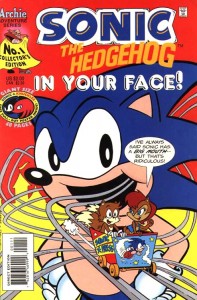 In the early 90’s, the continuity of the Saturday morning series Sonic the Hedgehog captured the hearts of numerous Sonic fans. For many, it was their very first exposure to the blue blur. For others, it was the chance to finally see their favorite hero animated on the small screen, even if it didn’t match up with the world they played in the games. Beginning with the second season, a storyline evolved that those who tuned in each week couldn’t wait to find out what happened next. They wanted to know what the future held for these characters, and if they would be able to reclaim their childhood home of Mobotropolis and defeat the evil Dr. Ivo Robotnik.
In the early 90’s, the continuity of the Saturday morning series Sonic the Hedgehog captured the hearts of numerous Sonic fans. For many, it was their very first exposure to the blue blur. For others, it was the chance to finally see their favorite hero animated on the small screen, even if it didn’t match up with the world they played in the games. Beginning with the second season, a storyline evolved that those who tuned in each week couldn’t wait to find out what happened next. They wanted to know what the future held for these characters, and if they would be able to reclaim their childhood home of Mobotropolis and defeat the evil Dr. Ivo Robotnik.
Television, much like comic books, can be a fickle medium. After two seasons the show went off the air, many thinking the comic book would follow suit. After all, how many licensed comics survived their source material? But to the surprise of many in the halls of Archie Comics, the title became more popular once the television series had unceremoniously ended, the four-color pages being the only outlet for those who felt unsatisfied with the cliffhanger ending of the cartoon. Even if the details were different, the future of these characters could be followed. Princess Sally, Antoine, Rotor, Bunnie and the rest could live on.
The idea of being able to show the “happily ever after,” though, was still something impossible. If the heroes defeated Robotnik and took back the kingdom, it would mean the end of the comic book as well. Even if the book is its own unique story, it still exists to serve as an advertisement to the games. There was no way Dr. Eggman could vanish from the book completely as long as he was the main antagonist in the video games. Sonic and Sally could not ride off into the sunset.
That didn’t mean Ken Penders wouldn’t try to show it anyway.